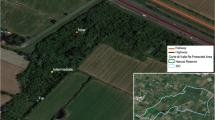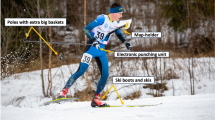Abstract
Physical limits of speed performances impose strong selective pressures on animals, influencing important functions such as predator avoidance and foraging success. Armoured herbivorous species such as tortoises represent a peculiar case: features that optimise encounter rate during reproduction, the ability to reach favourable sites for thermoregulation and resting, foraging or nesting sites may be more important than running speed. To explore this issue, we measured three characteristics related to travelling ability but that are independent of running speed: (1) muscular strength, (2) time needed for overturning and (3) jumping from a high step as proxies of the ability to overcome various obstacles. Additionally, reaction times in tortoises placed in a normal or overturned position were measured as a proxy of antipredator response. More than 400 adult Hermann’s tortoises from six populations were tested in the field during two seasons. Measures of travelling ability and antipredator response varied markedly among populations, and thus with environmental characteristics such as habitat type, terrain ruggedness and presence of predators. Tortoises from rugged and hot habitats (e.g. Mediterranean macchia) were the most successful and the fastest to accomplish the tests. Overturned tortoises were more reluctant to start moving compared to those in normal position, but this effect was absent in the two localities free from predators. Sex and season had limited effect on the measured performances. Overall, locomotor features essentially varied with environmental constraints. Future environmental studies should explore whether the observed differences among populations are linked to genetic adaptation or phenotypic plasticity.
Significance statement
Locomotor performances crucially influence habitat use, foraging and reproductive success, thus directly affecting individual fitness. Although running speed is often considered as a main indicator of agility, in armoured terrestrial vertebrates some other agility components might be more important. Heavy, rigid armour imposes trade-off between protection of soft body parts and locomotor performances and consequently habitat use. This study compiles three tests of locomotor performance which might be important for overcoming various obstacles present in mosaic habitats of tortoises. Testing adult Hermann’s tortoises from six populations with various habitat characteristics, we found significant inter-population differences. The ability of tortoises to complete the tests positively correlates with climatic conditions and topography of their habitats. Additionally, presence of predators in the habitats dramatically affects tortoise’s antipredator behaviour. Measured locomotor performances and antipredator behaviour showed surprisingly low level of sexual dimorphism.



Similar content being viewed by others
References
Blumstein DT (2002) Moving to suburbia: ontogenetic and evolutionary consequences of life on predator-free islands. J Biogeogr 29:685–692
Bonnet X, Aubret F, Lourdais O, Ladyman M, Bradshaw D, Maumelat S (2005) Do ‘quiet‘ places make animals placid? Island vs. mainland tiger snakes. Ethology 111:573–592
Bonnet X, Lagarde F, Henen BT, Corbin J, Nagy KA, Naulleau G, Balhoul K, Chastel O, Legrand A, Cambag R (2001) Sexual dimorphism in steppe tortoises (Testudo horsfieldii): influence of the environment and sexual selection on body shape and mobility. Biol J Linn Soc 72:357–372
Burnham KP, Anderson DR (2002) Model selection and multimodel inference: a practical information-theoretic approach, 2nd edn. Springer, New York
Đorđević S, Đurakić M, Golubović A, Ajtić R, Tomović L, Bonnet X (2011) Sexual body size and body shape dimorphism of Testudo hermanni in central and eastern Serbia. Amphibia-Reptilia 32:445–458
EEA (2013) Digital Elevation Model over Europe (EU-DEM). European Environtal Agency, http://www.eea.europa.eu/data-and-maps/data/eu-dem
Ghalambor CK, Walker JA, Reznick DN (2003) Multi-trait selection, adaptation and constraints on the evolution of burst swimming performance. Integr Comp Biol 43:431–438
Goodman BA, Miles DB, Schwarzkopf L (2008) Life on the rocks: habitat use drives morphological and performance evolution in lizards. Ecology 89:3462–3471
Golubović А (2015) Ontogenetic shift of antipredator behaviour in Hermann’s tortoises. Behav Ecol Sociobiol 69:1201–1208
Golubović А, Anđelković М, Arsovski D, Vujović A, Iković V, Đorđević S, Tomović L (2014) Skills or strength—how tortoises cope with dense vegetation? Acta Ethol 17:141–147
Golubović A, Arsovski D, Ajtić R, Tomović L, Bonnet X (2013a) Moving in the real world: tortoises take the plunge to cross steep steps. Biol J Linn Soc 108:719–726
Golubović A, Bonnet X, Djordjević S, Djurakić M, Tomović L (2013b) Variations in righting behaviour across Hermann’s tortoise populations. J Zool 291:69–75
Hailey A (1989) How far do animals move? Routine movements in a tortoise. Can J Zool 67:208–215
Hijmans RJ, Cameron SE, Parra JL, Jones PG, Jarvis A (2005) Very high resolution interpolated climate surfaces for global land areas. Int J Climatol 25:1965–1978
Huey RB, Dunham AE, Overall KL, Newman RA (1990) Variation in locomotor performance in demographically known populations of the lizard Sceloporus merriami. Physiol Zool 63:845–872
Ibáñez A, López P, Martín J (2014) Inter-individual variation in antipredator hiding behaviour of Spanish terrapins depends on sex, size and coloration. Ethology 120:1–11
Ireland LC, Gans C (1972) The adaptive significance of the flexible shell of the tortoise Malacochersus tornieri. Anim Behav 20:778–781
Jayne BC, Bennett AF (1990) Selection on locomotor performance capacity in a natural population of garter snake. Evolution 44:1204–1229
Kaliontzopoulou A, Bandeira V, Carretero MA (2012) Sexual dimorphism in locomotor performance and its relation to morphology in wall lizards (Podarcis bocagei). J Zool 289:294–302
Kelly CD, Bussiere L, Gwynne DT (2008) Sexual selection for male mobility in a giant insect with female-biased size dimorphism. Am Nat 172:417–423
Kohlsdorf T, James RS, Carvalho JE, Wilson RS, Dal Pai-Silva M, Navas CA (2004) Locomotor performance of closely related Tropidurus species: relationships with physiological parameters and ecological divergence. J Exp Biol 207:1183–1192
Lagarde F, Bonnet X, Henen B, Legrand A, Corbin J, Nagy K, Naulleau G (2003) Sex divergence in space utilisation in the steppe tortoise (Testudo horsfieldi). Can J Zool 81:380–387
Lagarde F, Louzizi T, Slimani T, El Mouden H, Ben Kaddour K, Moulherat S, Bonnet X (2012) Bushes protect tortoises from lethal overheating in arid areas of Morocco. Environ Conserv 39:172–182
Lailvaux SP, Husak JF (2014) The life history of whole-organism performance. Q Rev Biol 89:285–317
Lailvaux SP, Irschick DJ (2006) A functional perspective on sexual selection: insight and future prospects. Anim Behav 72:263–273
Le Galliard JF, Clobert J, Ferrière R (2004) Physical performance and darwinian fitness in lizards. Nature 432:502–505
Lepeigneul O, Ballouard JM, Bonnet X, Beck E, Barbier M, Ekori A, Buisson E, Caron S (2014) Immediate response to translocation without acclimation from captivity to the wild in Hermann’s tortoise. Eur J Wildl Res 60:897–907
Longepierre S, Hailey A, Grenot C (2001) Home range area in the tortoise Testudo hermanni in relation to habitat complexity: implications for conservation of biodiversity. Biodivers Conserv 10:1131–1140
Makiguchi Y, Nii H, Nakao K, Ueda H (2016) Sex differences in metabolic rate and swimming performance in pink salmon (Oncorhynchus gorbuscha): the effect of male secondary sexual traits. Ecol Freshw Fish 26:322–332
Martín J, Marcos I, López P (2005) When to come out from your own shell: risk-sensitive hiding decisions in terrapins. Behav Ecol Sociobiol 57:405–411
Mazerolle JM (2013) AICcmodavg: model selection and multimodel inference based on (Q)AIC(c). R package version 1:35 http://CRAN.R-project.org/package=AICcmodavg
Melville J, Swain R (2000) Evolutionary relationships between morphology, performance, and habitat openness in the lizard genus Niveoscincus (Scincidae: Lygosominae). Biol J Linn Soc 70:667–683
Miles DB (1994) Population differentiation in locomotor performance and the potential response of a terrestrial organism to global environmental change. Am Zool 34:422–436
Miles DB, Sinervo B, Hazard LC, Svensson EI, Costa D (2007) Relating endocrinology, physiology and behaviour using species with alternative mating strategies. Funct Ecol 21:653–665
Moulherat S, Delmas V, Slimani T, El Mouden H, Louzizi T, Lagarde F, Bonnet X (2014) How far can a tortoise walk in open habitat before overheating? Implications for conservation. J Nat Conserv 22:186–192
Oufiero CE, Garland T Jr (2007) Evaluating performance costs of sexually selected traits. Funct Ecol 21:676–689
Pinheiro J, Bates D, DebRoy S, Sarkar D, Core Team R (2014) Nlme: linear and nonlinear mixed effects models. R package version 3:1–117 http://CRAN.R-project.org/package=nlme
Polo-Cavia N, López P, Martín J (2008) Interspecific differences in responses to predation risk may confer competitive advantages to invasive freshwater turtle species. Ethology 114:115–123
R Core Team (2014) R: a language and environment for statistical computing. R Foundation for Statistical Computing, Vienna, Austria, http://www.R-project.org/
Revell LJ, Johnson MA, Schulte JAI, Kolbe JJ, Losos JB (2007) A phylogenetic test for adaptive convergence in rock-dwelling lizards. Evolution 61:2898–2912
Rozylowicz L, Popescu VD (2012) Habitat selection and movement ecology of eastern Hermann’s tortoises in a rural Romanian landscape. Eur J Wildl Res 59:47–55
Rubin S, Young MHY, Wright JC, Whitaker DL, Ahn AN (2016) Exceptional running and turning performance in a mite. J Exp Biol 219:676–685
Sibeaux A, Michel CL, Bonnet X, Caron S, Fournière K, Gagno S, Ballouard JM (2016) Sex-specific ecophysiological responses to environmental fluctuations of free-ranging Hermann’s tortoises: implication for conservation. Conserv Physiol 4:cow054
Sinervo B, Huey RB (1990) Allometric engineering: an experimental test of the causes of interpopulational differences in performance. Science 248:1106–1109
Stojadinović D, Milošević D, Crnobrnja-Isailović J (2013) Righting time versus shell size and shape dimorphism in adult Hermann’s tortoises: field observations meet theoretical predictions. Anim Biol 63:381–396
Turchin P (1998) Quantitative analysis of movement: measuring and modeling population redistribution in animals and plants. Sinauer, Sunderland
Vitt LJ, Caldwell PA, Zani P, Titus TA (1997) The role of habitat shift in the evolution of lizard morphology: evidence from tropical Tropidurus. P Natl Acad Sci USA 94:3828–3832
Willemsen RE, Hailey A (2003) Sexual dimorphism of body size and shell shape in European tortoises. J Zool 260:353–365
Wilson MFJ, O’Connell B, Brown C, Guinan JC, Grehan AJ (2007) Multiscale terrain analysis of multibeam bathymetry data for habitat mapping on the continental slope. Mar Geod 30:3–35
Zani PA, Gottschall JS, Kram R (2005) Giant Galapagos tortoises walk without inverted pendulum mechanical-energy exchange. J Exp Biol 208:1489–1494
Zani PA, Kram R (2008) Low metabolic cost of locomotion in ornate box turtles, Terrapene ornata. J Exp Biol 211:3671–3676
Zera AJ, Harshman LG (2001) The physiology of life history trade-offs in animals. Annu Rev Ecol Syst 32:95–126
Zuffi MAL, Plaitano A (2007) Similarities and differences in adult tortoises: a morphological approach and its implication for reproduction and mobility between species. Acta Herpetol 2:79–86
Acknowledgements
We are thankful to our colleagues Vuk Iković, Ana Vujović, Sonja Nikolić, Goran Šukalo, Rastko Ajtić and Gordan Kurbalija and his family for help during fieldwork. Miloš Popović helped with extracting ruggedness and climatic data. Research was partially financed by the Ministry of Education, Sciences and Technology of Republic of Serbia (grant no. 173043). We are thankful to the authorities for issuing the following permits: National Park “Galičica” (no. 11-4093/5), Agency for Environment Protection of Montenegro (no. UPI 2342/6) and Ministry of Environment, Mining and Spatial Planning of Serbia (no. 353-01-46/2012-03). We are thankful to two anonymous reviewers for helpful comments and suggestions.
Author information
Authors and Affiliations
Corresponding author
Ethics declarations
Data availability statement
The datasets generated and analysed during the current study are available from the corresponding author on reasonable request.
Funding
This study was funded by the Ministry of Education, Sciences and Technology of Republic of Serbia (grant no. 173043).
Conflict of interest
The authors declare that they have no conflict of interest.
Ethical approval
Experiments comply with the current laws of the countries in which they were performed. With the permissions of National Park “Galičica” (no. 11-4093/5), Agency for Environment Protection of Montenegro (no. UPI 2342/6) and Ministry of Environment, Mining and Spatial Planning of Serbia (no. 353-01-46/2012-03), animals were processed in the field. After non-invasive tests and measuring, which lasted up to 1 h, examinees were immediately released at the place of capture.
Additional information
Communicated by T. Madsen
Electronic supplementary material
ESM 1
(PDF 110 kb)
Rights and permissions
About this article
Cite this article
Golubović, A., Anđelković, M., Arsovski, D. et al. Locomotor performances reflect habitat constraints in an armoured species. Behav Ecol Sociobiol 71, 93 (2017). https://doi.org/10.1007/s00265-017-2318-0
Received:
Revised:
Accepted:
Published:
DOI: https://doi.org/10.1007/s00265-017-2318-0




